The Wheelchair Guide
Your Wheelchair and Mobility Scooter Resource
Manual Wheelchairs vs Electric Wheelchairs
Monday, August 3rd, 2009
Wheelchairs are a popular mobility aid that greatly improves the lives of millions of people all over the world. The manual wheelchair has been around for thousands of years, while the electric wheelchair is relatively new, with the first electric wheelchair being developed in the early 1950′s. Choosing between a manual wheelchair or an electric wheelchair is an important decision that should be based upon the needs and requirements of its user.
Consider the Physical Capabilities of the User
One of the most important considerations when choosing between a manual or electric wheelchair is the physical abilities of the wheelchair user. Using a manual wheelchair requires a lot of upper body strength and can be very tiring even for someone who is in perfect health. In addition to having fairly good physical fitness, it is also necessary to use both arms to push a manual wheelchair.
An electric wheelchair, on the other hand, can be controlled by only using a single finger and there are also a number of other alternate controls as well. Alternate wheelchair controls include head controlled wheelchairs and breath controlled wheelchairs. This allows even someone with greatly reduced physical capabilities to use a wheelchair.
Consider Where the Wheelchair Will Be Used
In addition to considering the condition of the wheelchair user, it is also necessary to consider where the wheelchair will be used and how far it will be driven everyday. If the wheelchair is primarily going to be used around the home, then a manual wheelchair might be a good choice, because even though it requires a good deal of physical effort, moving between rooms does not present a very large traveling distance.
If, on the other hand, you intend to use the wheelchair away from home across a larger distance, an electric wheelchair might be a better choice. As an example, traveling across a college campus would be much more strenuous than traveling between rooms in a house. The per charge range of an electric wheelchair varies, but most can travel between 10 and 20 miles without needing to be recharged.
In addition to considering how far one will be traveling in the wheelchair, it is also important to consider what type of terrain will be traveled over. It takes much more effort to move up and down hills than it does to move across straight ground in a manual wheelchair. Some electric wheelchairs are also much better choices for off road use, although it is also possible to buy off road wheels for manual wheelchairs.
Consider the Cost of the Wheelchair
Finally, it is also important to consider the wheelchair users budget, when deciding between a manual wheelchair or an electric wheelchair. There are of course exceptions to the rule on both sides, but typically a manual wheelchair costs significantly less than an electric wheelchair. Usually a quality electric wheelchair costs between $3,500 and $7,000, while a manual wheelchair costs between $300 and $1,500.
When considering cost, it is important to take into account insurance programs, such as Medicare or Medicaid, which will often help to offset the cost of a wheelchair. For example, in the case of Medicare, typically 80% of the cost of the wheelchair is covered, so this can greatly offset the expense of an electric wheelchair.
Vertical Platform Lifts vs Wheelchair Ramps
Tuesday, July 21st, 2009
For those that use wheelchairs, the stairs can present an obstacle that is very difficult to overcome. In some cases, it is possible to simply avoid traveling in areas that have stairs. However, around the home simply avoiding the stairs is typically neither practical or possible. There are several options to help make a homes staircase more accessible, but most people either install a vertical platform lift or a wheelchair ramp. Both of these options have their own advantages and disadvantages, which should be carefully weighed when making a home accessible.
Vertical Platform Lifts
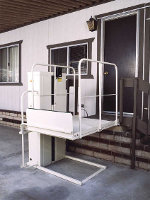 Vertical platform lifts are one of the most efficient ways of allowing a wheelchair user to travel over the stairs. Vertical platform lifts, which are often referred to as wheelchair lifts, are basically like a self contained elevator. The lifting platform, motor, and elevator shaft are all contained in a single unit, which can be placed next to a staircase to improve accessibility. The lifting height varies by model, but most have a default lifting height of around four feet, which can then be upgraded to about twelve feet.
Vertical platform lifts are one of the most efficient ways of allowing a wheelchair user to travel over the stairs. Vertical platform lifts, which are often referred to as wheelchair lifts, are basically like a self contained elevator. The lifting platform, motor, and elevator shaft are all contained in a single unit, which can be placed next to a staircase to improve accessibility. The lifting height varies by model, but most have a default lifting height of around four feet, which can then be upgraded to about twelve feet.
Vertical platform lifts are plugged into a normal electrical outlet and provide a platform for the user to drive their wheelchair onto. Then, the platform can be raised and lowered to allow full access to the home. Some wheelchair lifts include locking gates, both on the lifting platform itself, as well as at the top of the staircase landing to increase safety. Locks are also available, which may be required for commercial wheelchair lifts.
Usually the weight capacity of a vertical platform lift is at least 500 pounds, although some can support more than this. It is possible for more than one person to use the wheelchair lift at once, providing this does not exceed the weight capacity. They can also be used to move boxes or other items up and down the stairs.
Vertical platform lifts require a strong base that can support the weight of the lift, as well as the weight of the people using it. The base can be made from concrete or wood, providing it is sufficient to support the weight and stable.
The cost of a vertical platform lift varies, but usually they cost between $3,500 and $11,000. The installation of a vertical platform lift is straightforward and not very difficult, but the unit itself can be very heavy, so getting it in place may be difficult for some.
Wheelchair Ramps
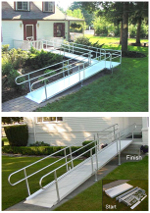 Installing a wheelchair ramp will often be a lower cost alternative to a wheelchair lift. Ramps can be custom made out of wood or metal ramp kits can be bought and assembled. The metal ramp kits typically come in sections, which are assembled at the home, and are referred to as modular wheelchair ramps. The height of the staircase will determine how many sections are needed. In some cases, modular wheelchair ramp kits can prove to be just as expensive as a wheelchair lift.
Installing a wheelchair ramp will often be a lower cost alternative to a wheelchair lift. Ramps can be custom made out of wood or metal ramp kits can be bought and assembled. The metal ramp kits typically come in sections, which are assembled at the home, and are referred to as modular wheelchair ramps. The height of the staircase will determine how many sections are needed. In some cases, modular wheelchair ramp kits can prove to be just as expensive as a wheelchair lift.
Wheelchair ramps offer the advantage of not requiring any electricity to function and since there are no moving parts, there is little about the ramp that can break. However, wheelchair ramps can take up a lot of space in a persons yard and the higher the staircase, the more space they will take up. Using a ramp can also prove to be very strenuous for those who use a manual wheelchair.
When choosing between a wheelchair ramp and a vertical platform lift, it is important to consider the location where the accessibility aid will be installed, as well as the condition of the person who will be using the device. However, for small staircases, which consist of only a step or two, there are a number of threshold ramps available that will be much more practical than a wheelchair lift would be.
Prescribing a Wheelchair: Follow Up Care
Monday, July 13th, 2009
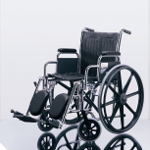 When a doctor prescribes a wheelchair to a user, it is very important that the wheelchair fits the needs of the user. It is also very important that the wheelchair user have a great deal of input over the process, because not only must their physical needs be met, but there are a number of other considerations, like where the person intends to primarily use their wheelchair, that should be considered.
When a doctor prescribes a wheelchair to a user, it is very important that the wheelchair fits the needs of the user. It is also very important that the wheelchair user have a great deal of input over the process, because not only must their physical needs be met, but there are a number of other considerations, like where the person intends to primarily use their wheelchair, that should be considered.
It is encouraged that new wheelchair users also talk with experienced wheelchair users and do a good deal of research on their own, because often doctors, while very well meaning, are not very experienced with wheelchairs and have never actually used one for an extended period of time. Due to health and safety concerns, it is very important that the wheelchair fits the physical requirements of the user.
Once the wheelchair arrives, everything should be remeasured and the wheelchair fully evaluated to ensure that it does in fact fit the needs of the user, however the doctors responsibility does not stop here. Instead, the wheelchair and its effect on the user should be reevaluated with each visit to the doctor.
One of the most important things that a doctor should look for is how the wheelchair is affecting the posture of its user. This is often something that can not be seen until after the user has been using the wheelchair for some time. Proper posture is essential for wheelchair users, because overtime a poor sitting position can cause a great number of health problems.
The actual condition of the wheelchair should also be checked and the user should be trained in how to properly maintain and care for their wheelchair. This includes lubricating moving parts, removing and cleaning the components, adjusting the anti-tip casters, and regularly checking the wheelchairs bolts for tightness. Emergency maintenance, such as how to fix a flat tire, should also be shown.
It is also very important that the wheelchair user be trained in how to navigate environmental factors that they might encounter. This includes the ability to move over curbs, navigate steps, and traveling on hills. Proper transfer techniques should also be shown and the user should be trained on how to fall out of the chair and recover. There are several places across the country that offer a sort of wheelchair obstacle course, to help train new wheelchair users and experienced wheelchair users alike.
The doctor should also make sure that the users home area is wheelchair friendly. It may be necessary to widen doors, install ramps, or a wheelchair lift. The doctor should talk with the patient and explain some of the options available.
Selecting the Right Wheelchair
Thursday, July 2nd, 2009
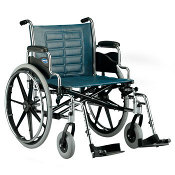 There are a number of decisions that go into prescribing a manual wheelchair and this decision should not be made lightly. This is because a wheelchair will be used daily and an improper fit could result in joint deformities, bruising, poor posture, circulation problems, and even pain. However, these problems can be avoided by ensuring that the wheelchair fits the user.
There are a number of decisions that go into prescribing a manual wheelchair and this decision should not be made lightly. This is because a wheelchair will be used daily and an improper fit could result in joint deformities, bruising, poor posture, circulation problems, and even pain. However, these problems can be avoided by ensuring that the wheelchair fits the user.
Size of the User
One of the most important considerations is the age of the wheelchair user, their size, and their weight. Wheelchairs come in a variety of sizes and so, it is seldom a problem finding one to fit an individual.
However, it is imperative that the seat is wide enough to accommodate their frame, the armrests do not rub their arms or cause discomfort, the backrest is not too high or too low, and the wheelchair can support the weight of the occupant. The height of the occupant is also important, so the wheelchair is not raised too high or low off of the ground.
Health and Condition of the User
The physical health and type of disability the new wheelchair user has is also a very important part of deciding what type of wheelchair will be the best choice. Since manual wheelchairs require good deal of upper body strength to use, they will not be the best choice for some, necessitating an electric power chair. Other considerations are the users ability to support their neck, how much flexibility they have in their legs, and circulation concerns, which could require the user to keep their feet elevated or have a reclining back.
Needs of the User
While the physical condition and attributes of the wheelchair user are essential, it is also imperative that the wheelchair can do what the user needs it to, so the needs and preferences of the wheelchair user should always be considered. For example, it should be determined if the user will be using the wheelchair only at home, at work, primarily outdoors, or a combination of all three. Other considerations include whether someone else will be pushing the wheelchair, how easy the wheelchair is to transport, and how the individual will transfer into and out of the chair.
Cost of the Wheelchair
Typically, the final consideration before actually ordering the wheelchair is the overall cost and purchasing power of the user. The order should be fine tuned to remove any unneeded features, which can add to the cost. The option to lease, buy, or rent should also be considered, as well as insurance or Medicare costs.
Ensuring that the wheelchair fits the specific needs and requirements of its user is imperative, not only for safety and health concerns, but also because the acceptance of a wheelchair by its user can affect their mental health.
What are Power Chairs?
Tuesday, June 2nd, 2009
The wheelchair is easily one of the most important medical devices of all time and its roots can be traced back thousands of years. Today, more and more people are using electric wheelchairs.
Electric wheelchairs were first developed in the nineteen-fifties when an electric motor was added to a manual wheelchair. They quickly became popular because a manual wheelchair requires a great deal of physical effort to use and a lot of upper body strength, making them impossible to use for many who are mobility challenged. An electric wheelchair, on the other hand, can be moved by only lifting a finger and there are a number of alternate wheelchair control systems available as well, such as a system that allows the wheelchair to be controlled by the breath of the user.
There are many manufacturers of electric wheelchairs, but two of the most well known are Golden Technologies and Pride Mobility. Both of these companies offer a wide assortment of home medical equipment, including a number of different electric wheelchairs. There are of course many other manufacturers, including ShopRider, so it is a good idea to explore all of your options when shopping for an electric wheelchair.
While there are many different models of electric wheelchairs available, they can typically be classified as either rear-wheel drive, mid-wheel drive, or travel wheelchairs.
Rear-wheel drive wheelchairs are propelled by their rear wheel and the weight of the user is evenly distributed across the electric wheelchairs base. Mid-wheel drive wheelchairs feature three rows of wheels, with the row in the middle being responsible for moving the wheelchair. A mid-wheel drive wheelchair is much more maneuverable than a Rear-wheel drive wheelchair, but the weight is not as evenly distributed, so it does not provide as stable of a platform. For most, the difference is negligible, but in some outdoor situations and for those who require a higher weight capacity, the rear-wheel drive wheelchair might be the best choice.
Travel wheelchairs come in several different designs, but are lighter and easier to transport than other electric wheelchairs. Some are designed so that they can be taken apart into easy to manage pieces and others share a design similar to a steel tubed manual wheelchair, allowing them to be folded up when not in use. They typically have a shorter range and fewer features, but can usually be transported without requiring a vehicle wheelchair lift, which would typically be required to transport non-travel wheelchairs.
For millions of people across the globe, the electric wheelchair allows for increased mobility and accessibility, allowing them to effortlessly move around.
Electric Wheelchairs for Seniors
Thursday, May 21st, 2009
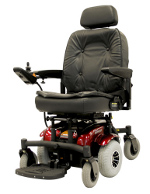 Electric wheelchairs, which are often also called power chairs, offer the advantage of a manual wheelchair, in that they are very maneuverable. However, unlike manual wheelchairs, power chairs are powered electronically, so they can typically be operated very easily, requiring very little physical activity of the senior.
Electric wheelchairs, which are often also called power chairs, offer the advantage of a manual wheelchair, in that they are very maneuverable. However, unlike manual wheelchairs, power chairs are powered electronically, so they can typically be operated very easily, requiring very little physical activity of the senior.
A simple joystick control scheme is most popular for controlling electric wheelchairs, which allows the senior to simply push the joystick. The joystick, which is attached to the arm of the power chair, then moves the wheelchair in the direction they wish to travel. Of course, there are a number of alternate wheelchair control systems available as well, including breath controlled systems and remote controlled systems, which are often used by caretakers.
A Brief Background on Electric Wheelchairs
The first electric wheelchairs, which were developed in the early 1950′s, were simply adapted E & J manual wheelchairs.
An electric motor was attached to the manual wheelchair, which was controlled using a simple joystick control scheme, although even during the 1950′s, researchers were already coming up with alternate control schemes. One popular method was to mount something similar to a joystick near the individuals head. They could then use their face to control the electric wheelchair.
The Modern Electric Wheelchair
Today, while some portable electric wheelchairs do use a traditional steel tubed folding wheelchair design, most look much different from a traditional manual wheelchair. Instead, an electric motor and battery is contained in the base of the wheelchair, usually covered by molded plastic.
A captains chair, which, depending on the cost of the power chair, often rivals that of most office chairs, both in comfort and durability, is mounted on the base of the wheelchair. The captains chair often reclines and swivels, to facilitate comfort and make transferring into and out of the wheelchair easier. Some even include an electric lifting system to raise and lower the chair.
While many power chairs share a similar design, one way they are often classified is by their wheels. A mid-wheel power chair features one set of large wheels in the middle of the base and one set of smaller wheels on the front and back of the base. The larger wheels are what does all of the work and are powered by the electric motor. The smaller set of wheels on either side of the drive wheels, provide extra support and stability.
The mid-wheel electric wheelchair offers the advantage of excellent maneuverability. It can turn in much smaller spaces. However, in some cases it might not offer the same stability as a rear-wheel drive wheelchair. This is because the center of balance for a mid-wheel wheelchair is in the middle of the power chairs base.
The other common type of electric power chair is the rear wheel drive wheelchair. These feature a set of rear wheels, which depending on the model might be slightly larger, and a set of front wheels, giving it four wheels in total. The rear wheels, are powered and what actually moves the power chair.
The rear wheel drive wheelchair does not offer the same maneuverability that a mid-wheel power chair does, but does offer increased stability. This is because the weight of the occupant is more evenly distributed across the base, making a wider center of balance.
As is the case with manual wheelchairs, power chairs, both mid-wheel and rear wheel drive models, include anti-tip casters to prevent the wheelchair from tipping over backwards.
Advantages of Electric Wheelchairs
One of the major advantages that an electric wheelchair offers is that it does not require much effort to use. Simply push the joystick and the power chair will move, with many offer very small turning radius and sensitive controls. The speed is often adjustable and some models can reach speeds of over 10 miles per hour.
The range of a power chair varies, but most can travel at least 5 miles without requring a recharge. Some can travel upwards of 20 or 30 miles per charge, but this often is dependent on the terrain and weight of the occupant. For example, if you decided to drive around the hills of San Fransisco, the battery would wear down much quicker than it would when used on flat land.
Along the same lines, if the rider weighed 300 pounds, the battery would wear down quicker than if they weighed 150 pounds. Often, an extra battery pack is purchased for those who use the power chair continuously, as this way when one battery pack wears down, it can be removed and charged, and the fresh battery pack used.
Electric Wheelchairs and Seniors
While the electric power chair can be an excellent device, especially for seniors, it is often cost prohibitive.
Of the three main mobility options, manual wheelchairs, electric wheelchairs, and mobility scooters, electric wheelchairs are by far the most expensive. When compared to mobility scooters, electric wheelchairs often also have a lower range, lower top speed, and are not as well suited to rough terrain. However, for indoor use, they are usually superior to scooters.
Wheelchair Basketball
Monday, November 10th, 2008
Wheelchairs have been used pretty much since the beginning of time, but until the 1900′s, they really didn’t resemble the wheelchairs of today. By the 1930′s, there were several steel tubed wheelchairs available that closely resemble the type of chair you see today. It was also around this time that wheelchairs sports first became popular.
The late 1930′s until the mid 1940′s, were a very violent time. Many millions of people lost their lives during World War II, but there were also a lot of medical advances, such as the use of penicillin to fight infection. Due to these advances, there was an increased number of soldiers who survived serious injuries, but were left disabled. It was this influx of disabled veterans that would lead to the development of wheelchair sports.
One of the first wheelchair sports to be played was wheelchair basketball. The first recorded game between veterans took place in 1946, but it is usually attributed, at least in part, to a German neurologist named Ludwig Guttmann. Guttmann fled Germany during the beginning of the Second World War. After the war, he founded the National Spinal Injuries Centre, which was located near London in Stoke Mandeville Hospital. He firmly believed that sports were an integral part of rehabilitation and would go on to found the Stoke Mandeville Wheelchair Games, which were the predecessor to the Paralympics.
After that first game of wheelchair basketball in 1946, the popularity would quickly spread among veterans and others who used wheelchairs. It became a part of the Stoke Mandeville Wheelchair Games in 1956 and the International Wheelchair Basketball Federation was founded in 1973. Today it is played by thousands in countries all over the World.
The Basics
Wheelchair basketball is played on a regulation basketball court and the rules are based off of the official NCAA rules, with some changes to address the needs of those in wheelchairs.
Generally in order to play, the individual must be affected by some sort of leg disability or paralysis that affects the lower part of their body, but there are some teams that have able bodied players on them. To achieve a balance, each player is ranked according to their abilities. The players are classified by their disability, for instance a player with complete motor loss would be classified as a Class I player. There is a set amount of points attached to each classification and the total point value of a teams active players can not be greater than 12. This is designed to create a team balance.
The wheelchair used to play wheelchair basketball must also meet several requirements. The height of the seat should not be greater than 21†and the foot rest should not be higher than 5â€. A seat cushion is permitted for each player, but it can not exceed 2†to 4†depending on the players classification. The wheelchairs are usually outfitted with anti-tip bars and other protective tools
General contact rules apply, such as charging and blocking, and the wheelchair is considered part of the players body. Players in possession of the ball may push their wheels to advance, but they can not push more than twice without either dribbling or passing the ball. Pushing more than twice is considered traveling.
A player will loose possession of the ball if they make any contact with the floor. This includes if the wheelchair tips back far enough that the anti-tip wheels make contact with the floor. Generally if a player falls from their chair, the referees will not stop the game unless there is a danger to the player.